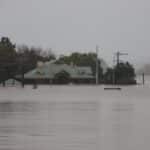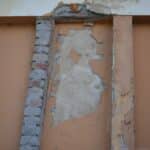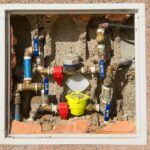Why Water Around Your Foundation is a Problem You Can’t Ignore
French drain outside systems are underground drainage solutions that collect and redirect water away from your home’s foundation. They consist of a gravel-filled trench and a perforated pipe that channels groundwater to a safe discharge point, preventing it from pooling against your foundation walls and pushing its way into your basement.
Quick Answer: What You Need to Know About Exterior French Drains
- What it is: A gravel-filled trench with a perforated pipe installed outside your foundation to intercept water before it reaches your basement.
- When you need one: You see basement flooding after rain, water pooling near the foundation, or persistent dampness.
- How it works: Collects groundwater and surface water, channeling it away from your home using gravity.
- Key benefit: Stops water at the source, protecting your foundation from hydrostatic pressure.
If you’ve ever found water on your basement floor after a heavy Maryland rainstorm, you’re not alone. We’ve seen it in countless homes across Baltimore City, Baltimore County, and Harford County. That water gets there because of hydrostatic pressure, which is groundwater building up in the soil and forcing its way through any crack it can find.
An exterior French drain solves this problem by intercepting water before it ever reaches your foundation. Think of it as a moat for your castle. However, they are more invasive and costly to install than interior systems. That’s what we’ll walk through in this guide. With over 70 years of experience waterproofing Maryland basements, we can help you find the right solution for your home.

What is an Exterior French Drain and Why Does Your Maryland Home Need One?
When you see water pooling next to your foundation after a Maryland thunderstorm, it’s actively looking for a way into your basement. A french drain outside your home is your first line of defense.
Understanding the Basics
A french drain outside is an underground trench system installed around your foundation’s perimeter to catch water before it reaches your basement walls. It creates an escape route for groundwater and surface runoff.
The system is straightforward in concept. A trench is dug around your foundation, lined with filter fabric, and filled with gravel and a perforated pipe. The fabric keeps out debris, while the gravel and sloped pipe create an easy, gravity-fed path for water to flow away from your home. You might hear these systems called weeping tile or a perimeter drain, but they all do the same job: giving water a better place to go than through your foundation. For a neutral overview of how these systems work, see the French drain article.
This proactive groundwater management is one of the most effective ways to prevent foundation damage. If your foundation is already showing signs of stress, our foundation repair services can address both the symptoms and the underlying water issues.
Exterior vs. Interior Drains: What’s the Difference?
We get this question daily: “Should the drain be inside or outside?” The honest answer depends on your home, but heres the main difference.
An exterior drain is a protective barrier that stops water before it touches your foundation. However, installing one requires excavating your entire perimeter, disrupting landscaping, and temporarily turning your yard into a construction zone. It stops water at the absolute source but is more invasive and costly.
An interior drain, on the other hand, is installed along your basement floor. It manages water that has already seeped through the foundation, collecting it and directing it to a sump pump. The biggest advantage is less disruption. We work inside, so your yard remains intact, and the job is usually faster and more budget-friendly. For most existing homes in Baltimore City and Baltimore County, an interior solution delivers proven waterproofing results without the upheaval of a full exterior excavation.
An exterior drain prevents water from reaching your foundation, while an interior system manages water that’s already inside. Both are effective, but they work at different stages. For new construction or homes with severe grading problems, an exterior system installed as part of exterior excavation waterproofing can be ideal.
Understanding the Role of a French Drain Outside Your Home
When water pools around your foundation, it’s actively working against your home. A french drain outside acts as a bodyguard, intercepting trouble before it causes damage. Instead of dealing with water after it has already invaded your basement, this system catches it at the source. It’s the difference between mopping up a flood and preventing one from ever happening.
Signs You Might Need a French Drain Outside
Your home will tell you when it has a water problem. The most obvious sign is a wet basement after rain. That water pushed its way through your foundation because it had nowhere else to go. Other key indicators include:
- Musty smells or visible mold, which mean moisture is getting in somewhere.
- Efflorescence, a white, chalky powder on basement walls left by evaporating water.
- Puddles near your foundation that don’t drain away.
- Sinking patios or walkways where water has washed out the supporting soil.
- A yard that stays soggy long after a storm.
These aren’t just cosmetic issues; they’re warnings that your foundation is under constant assault. You can learn more from our guide on 6 Signs You Need to Get Your Basement Waterproofed.
The Professional Process for Installing a French Drain Outside
Installing a french drain outside is a serious project, not a weekend DIY task. A professional installation is a complex process involving careful planning, safe excavation around your foundation, applying a waterproofing membrane to the wall, and installing a multi-component drainage system. This meticulous approach requires specialized equipment and expertise to ensure the system is designed to channel water away effectively for decades. This professional approach is what guarantees the system will protect your home, and you can learn more on our page about exterior excavation waterproofing.

Challenges, Costs, and Long-Term Benefits
An exterior French drain is a major project. The biggest challenge is the excavation, which will temporarily disrupt your landscaping, driveway, or patios. The cost is also higher than interior solutions due to the extensive labor and restoration work.
But for many homeowners in Baltimore County and Harford County, the investment is worth it for the long-term foundation protection. By stopping water at the source, you eliminate the hydrostatic pressure that causes foundation cracks and bowing walls. A dry basement prevents mold and wood rot, protects your home’s structural integrity, and adds real value to your property. The peace of mind you get from knowing your home is protected during Maryland’s wettest storms is priceless. To keep your system running smoothly, we offer regular inspections through our maintenance plans.
Is an Exterior Drain Always the Right Choice?
After seven decades in this business, we know an exterior French drain is a powerful tool, but it’s not always the best one for the job. Every home in Baltimore City, Baltimore County, and Harford County has a unique relationship with water, and the right solution depends on the root cause of the problem.
Comparing Drainage Solutions for Your Home
An exterior drain makes perfect sense for new construction or when you’re already doing major landscaping. It’s also the right call for homes in low spots that face massive amounts of surface water.
More often, however, we find that an interior drainage system can solve a wet basement problem for less money and without tearing up a beautiful yard. Interior drains are less disruptive, can be installed year-round, and are easier to access for maintenance. They work with a sump pump to collect and expel water that seeps in. You can learn more about Why Add a Sump Pump? on our blog.
We believe in a holistic approach. Sometimes, the best solution is a combination of fixes. Proper yard grading and extending your downspouts can dramatically reduce the amount of water your system needs to handle. A complete solution might pair these improvements with an interior drain and sump pump to keep your basement bone dry. Our guide on Comparing Basement Waterproofing Systems breaks down the pros and cons of each approach.
Get a Lasting Solution with a Trusted Local Expert
We know this is a lot to think about. That’s where our 70 years of experience really matters. We’ve worked on everything from century-old Baltimore rowhomes to modern suburban houses, and we’ve learned to identify the true cause of a water problem.
When you call us for a free inspection, we won’t push a one-size-fits-all solution. We’ll give you our honest, expert assessment and explain our recommendations. Every foundation repair and encapsulation project we do comes with a transferable lifetime guarantee. That’s confidence built on decades of doing the work right. We’re engineering-backed, partnering with structural engineers on major repairs to ensure the solution will last.
We’re your neighbors. We understand Maryland weather and are here to help you protect your home from it. If you’re tired of dealing with a damp basement, don’t wait for a small problem to become a big one. Get a free inspection for your Baltimore home today and let’s find the right solution for you.







